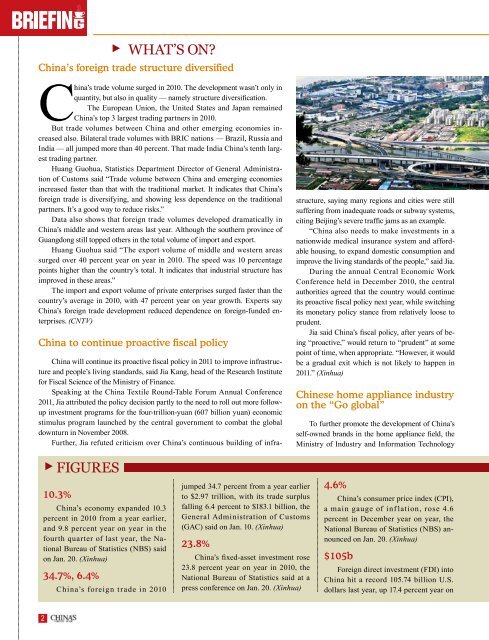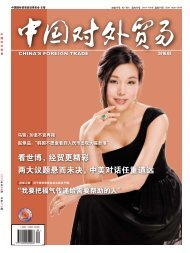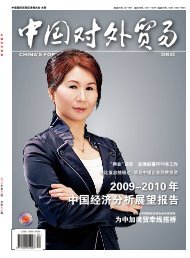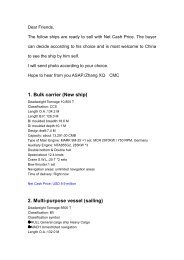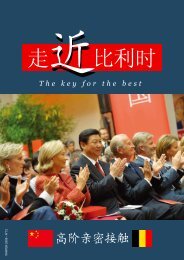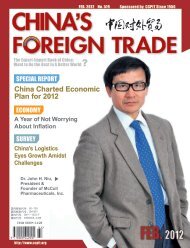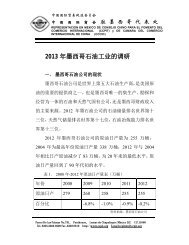You also want an ePaper? Increase the reach of your titles
YUMPU automatically turns print PDFs into web optimized ePapers that Google loves.
What’s on?<br />
China’s foreign trade structure diversified<br />
China’s trade volume surged in 2010. The development wasn’t only in<br />
quantity, but also in quality — namely structure diversification.<br />
The European Union, the United States and Japan remained<br />
China’s top 3 largest trading partners in 2010.<br />
But trade volumes between China and other emerging economies increased<br />
also. Bilateral trade volumes with BRIC nations — Brazil, Russia and<br />
India — all jumped more than 40 percent. That made India China’s tenth largest<br />
trading partner.<br />
Huang Guohua, Statistics Department Director of General Administration<br />
of Customs said “Trade volume between China and emerging economies<br />
increased faster than that with the traditional market. It indicates that China’s<br />
foreign trade is diversifying, and showing less dependence on the traditional<br />
partners. It’s a good way to reduce risks.”<br />
Data also shows that foreign trade volumes developed dramatically in<br />
China’s middle and western areas last year. Although the southern province of<br />
Guangdong still topped others in the total volume of import and export.<br />
Huang Guohua said “The export volume of middle and western areas<br />
surged over 40 percent year on year in 2010. The speed was 10 percentage<br />
points higher than the country’s total. It indicates that industrial structure has<br />
improved in these areas.”<br />
The import and export volume of private enterprises surged faster than the<br />
country’s average in 2010, with 47 percent year on year growth. Experts say<br />
China’s foreign trade development reduced dependence on foreign-funded enterprises.<br />
(CNTV)<br />
China to continue proactive fiscal policy<br />
China will continue its proactive fiscal policy in 2011 to improve infrastructure<br />
and people’s living standards, said Jia Kang, head of the Research Institute<br />
for Fiscal Science of the Ministry of Finance.<br />
Speaking at the China Textile Round-Table Forum Annual Conference<br />
2011, Jia attributed the policy decision partly to the need to roll out more followup<br />
investment programs for the four-trillion-yuan (607 billion yuan) economic<br />
stimulus program launched by the central government to combat the global<br />
downturn in November 2008.<br />
Further, Jia refuted criticism over China’s continuous building of infra-<br />
structure, saying many regions and cities were still<br />
suffering from inadequate roads or subway systems,<br />
citing Beijing’s severe traffic jams as an example.<br />
“China also needs to make investments in a<br />
nationwide medical insurance system and affordable<br />
housing, to expand domestic consumption and<br />
improve the living standards of the people,” said Jia.<br />
During the annual Central Economic Work<br />
Conference held in December 2010, the central<br />
authorities agreed that the country would continue<br />
its proactive fiscal policy next year, while switching<br />
its monetary policy stance from relatively loose to<br />
prudent.<br />
Jia said China’s fiscal policy, after years of being<br />
“proactive,” would return to “prudent” at some<br />
point of time, when appropriate. “However, it would<br />
be a gradual exit which is not likely to happen in<br />
2011.” (Xinhua)<br />
Chinese home appliance industry<br />
on the “Go global”<br />
To further promote the development of China’s<br />
self-owned brands in the home appliance field, the<br />
Ministry of Industry and Information Technology<br />
Figures<br />
10.3%<br />
China’s economy expanded 10.3<br />
percent in 2010 from a year earlier,<br />
and 9.8 percent year on year in the<br />
fourth quarter of last year, the National<br />
Bureau of Statistics (NBS) said<br />
on Jan. 20. (Xinhua)<br />
34.7%, 6.4%<br />
China’s foreign trade in 2010<br />
jumped 34.7 percent from a year earlier<br />
to $2.97 trillion, with its trade surplus<br />
falling 6.4 percent to $183.1 billion, the<br />
General Administration of Customs<br />
(GAC) said on Jan. 10. (Xinhua)<br />
23.8%<br />
China’s fixed-asset investment rose<br />
23.8 percent year on year in 2010, the<br />
National Bureau of Statistics said at a<br />
press conference on Jan. 20. (Xinhua)<br />
4.6%<br />
China’s consumer price index (CPI),<br />
a main gauge of inf lation, rose 4.6<br />
percent in December year on year, the<br />
National Bureau of Statistics (NBS) announced<br />
on Jan. 20. (Xinhua)<br />
$105b<br />
Foreign direct investment (FDI) into<br />
China hit a record 105.74 billion U.S.<br />
dollars last year, up 17.4 percent year on<br />
2


